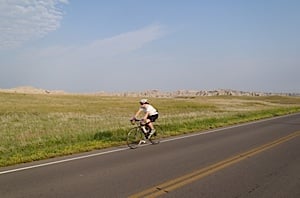Cool air, soft light, and smooth pavement greeted us as we rode into Badlands National Park, a park whose name suggests unforgiving ruggedness but which offers a sweet ride that leads you through those badlands and across windswept prairie.
The early hour -- we were up by 5:30 a.m. and pedaling by 7 a.m. -- was a key ingredient of the ride, as my wife and I didn't want to be overcome by the 100-degree temperatures that would envelope Badlands by midday. Another bonus to the cool air was the empty pavement: we had the road to ourselves.
Road-biking in the national parks can be an iffy proposition if you're not strategic. Many park roads, while smoothly paved, lack bike lanes and can feature quick dropoffs. With big rigs hauling fifth-wheels and ponderous RVs with their outreached mirrors touring the parks in summer, you want to get your cycling in when those rigs are parked.

The badlands seem to swallow you as you ride the park road. Kurt Repanshek photo.
Badlands does not offer a great length of road for cyclists: Between the Pinnacles Entrance on the north end of the park's North Unit and the Interior Entrance on the south end, you've only got 24 miles of paved road along the Badlands Loop Road (a curious name in that there's no loop unless you go out of the park along Route 44 and then tie into the Sage Creek Road, a 25.5-mile-long gravel and dirt stretch that would devour road-bike tires before you'd reconnect with the paved park road near the Pinnacles Overlook).
But if you're only looking for an hour or two of cycling to stretch the muscles and reconnect with your bike, smell the fresh air, catch bird calls on the wind along with the barks of annoyed prairie dogs, this is a great stretch of pavement to glide along.
Enter through the Pinnacles Entrance and you'll enjoy an outbound ride that slowly drops in elevation. That's great if you've arranged a shuttle or a pickup, but if you're on an out-and-back ride, you might want to start at the Interior Entrance and take advantage of the slight descent on your way back to your rig.

Once you top Dillon Pass coming from the north, the ride takes you through mixed-grass prairie and offers some great overlooks. Kurt Repanshek photo.
We entered through the Pinnacles Entrance not long after the sun crested the eastern horizon, and immediately swooped through a steep S-curve that pulled us right into the landscape. To the right and left the eroded landscape rose about us.
Though not as colorful as the Painted Desert at Petrified Forest National Park, these badlands had lots of character even with their predominant gray coloring interrupted by umber banding and occasional yellows. Steep flanks and sharp ridges towered about us, only to give way to sweeping grasslands once we made the short climb up and over Dillon Pass.
Scenic overlooks make it hard to get into a good rhythm, as you're constantly tempted to dismount and shoot some pictures. We started our ride at the Pinnacles Overlook, and after that S-curve came to Ancient Hunters Overlook, and then Yellow Mounds Overlook. While the first overlook provided panoramic views out across the badlands, at Yellow Mounds we gained a look down between two bands of badlands and out across a green grassy prairie dotted with slight mounds colored yellow by the severely weathered soils. The early morning sun provided just the right amount of soft light to bring this setting vividly to life, even if it was early July.
Up over Dillon Pass brought us to the Conata Basin Overlook, where we enjoyed views both down to the Yellow Mounds and out across the rugged badlands that squeeze the park road.
The Homestead Overlook is disappointing if you're hoping to see some early 20th century homestead ruins. Instead you're treated to an expansive sweep of prairie that attracted scores of homesteaders who soon realized they couldn't make a go of it here.
The ride from the top of Dillon Pass to the Panorama Point Overlook is superb: wide, smooth, and mostly flat with a few rollers tossed in. Heading south, to your left runs the mixed-grass prairie, interrupted occasionally by prairie dog colonies, and to your right the terrain drops off sharply to more prairie pierced by badland formations.
While we constantly looked for some of the park's bison, we were disappointed. However, we did spy a hen turkey with one of her chicks, and just inside the Pinnacles Entrance was a band of bighorn sheep.

Though it was early July, there was plenty of color in the Yellow Mounds. Kurt Repanshek photo.
From Panorama Point the road slowly descends to Cedar Pass, the park's main visitor center and the Cedar Pass Lodge, where you can cool off with ice cream and cold drinks. It's a relatively short ride ... unless you double back and turn that 24-miler into a 48-miler. It's an appetizing idea...if you get that early morning start.
If You Go
Distance: 24 one-way miles, 48 miles roundtrip.
Starting Point: Either the Pinnacles or Interior entrance stations. Start at Pinnacles, and it's largely downhill. Start at Interior, and the last mile is an uphill grind.
Cautions: Start early in the morning in summer, or be prepared for brutally hot temperatures and winds. Watch for rattlesnakes if you stop and stray off trail to the overlooks. Bring water...and then some more water.
Payoffs: Soft morning light makes for great photos, and the early hour virtually assures you'll have the road to you and your bike.


 Support Essential Coverage of Essential Places
Support Essential Coverage of Essential Places







Comments
Thanks for this. I've been searching for a solid ride through badlands. I'll take this route tomorrow, and let everyone know if I have similar experience.